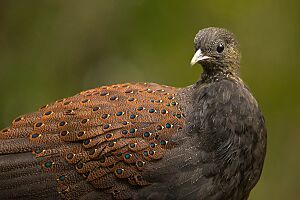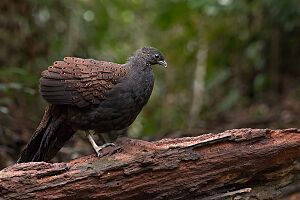Mountain peacock-pheasant facts for kids
Quick facts for kids Mountain peacock-pheasant |
|
|---|---|
 |
|
| Conservation status | |
| Scientific classification | |
| Genus: |
Polyplectron
|
| Species: |
inopinatum
|
| Synonyms | |
|
Chalcurus inopinatus Rothschild, 1903 |
|
The mountain peacock-pheasant (Polyplectron inopinatum) is a special bird found in Malaysia. It is also known as Rothschild's peacock-pheasant or the mirror pheasant. This bird is a type of pheasant that can grow up to 65 centimeters long. It has a blackish-brown body with unique, shiny spots.
Contents
About the Mountain Peacock-Pheasant
What Does It Look Like?
The mountain peacock-pheasant is a medium-sized bird. Both male and female birds look quite similar. They are mostly blackish-brown. They have small, round, shiny spots called ocelli on their feathers. They also have long tail feathers that get longer towards the end.
The male bird has bright, metallic blue ocelli on its upper body. Its tail has twenty feathers with green ocelli. Males also have two sharp spurs on each leg. These are like small spikes.
The female bird is a bit smaller and less colorful than the male. She has black ocelli on her upper body. Her legs do not have spurs. Her tail has eighteen feathers.
Where Does It Live?
This bird is quite shy and hard to spot. It lives only in the central part of the Malay Peninsula. You can find it in the mountain forests there. This means it is endemic to that area.
The mountain peacock-pheasant eats mostly berries, beetles, and ants. It finds its food on the forest floor.
Its Family Tree
Scientists have studied the mountain peacock-pheasant's DNA. They found that it belongs to a group of birds with the bronze-tailed peacock-pheasant, Germain's peacock-pheasant, and grey peacock-pheasant. This means they are all related. This species likely developed in Southeast Asia a long time ago.
Protecting This Bird
Sadly, the mountain peacock-pheasant is a vulnerable bird. This means it is at risk of disappearing. Its home, the forest, is shrinking. There are also not many of these birds left.
Because of these reasons, it is listed on the IUCN Red List of Threatened Species. In Malaysia, it is also protected under CITES rules. This helps to make sure people do not harm or trade these special birds.




